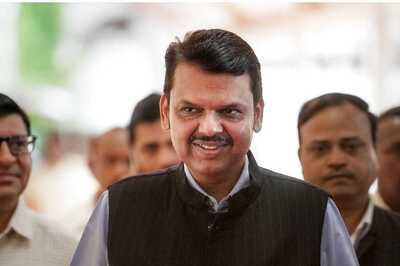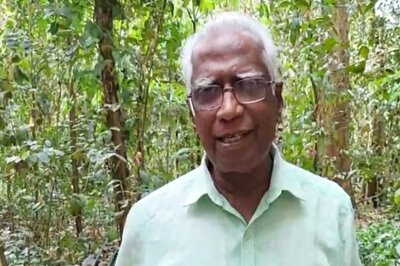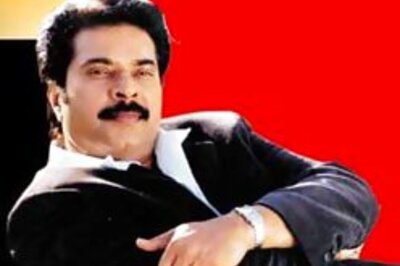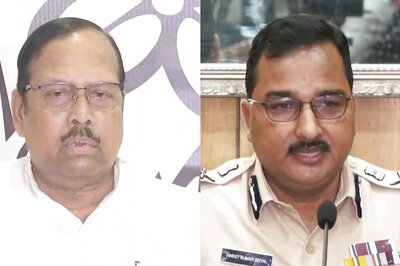
views
The swearing-in of Prime Minister Narendra Modi to mark his second term in the forecourt of the illuminated Rashtrapati Bhavan on May 30 evening was more than one tale to remember.
As those seated on the stage waited for their turn to take oath of office after Modi, TV cameras panned to the front row of the audience that was a galaxy of who’s who.
But the most familiar faces were that of a set of BJP veterans — Venkaiah Naidu (Vice President of India), LK Advani, Murli Manohar Joshi, and a new entrant, Sushma Swaraj.
Swaraj’s exclusion — along with Arun Jaitley’s opting out of the swearing-in exercise for health reasons — did raise eyebrows and, perhaps, made one wonder whether it was the final curtains on an era of late Atal Bihari Vajpayee at the helm and Advani as the virtual helmsman.
Both of whom charted the BJP’s journey from a party of two MPs to what it is today — a powerful political machine.
Of course, there is every possibility that Swaraj moves into a gubernatorial role shortly or Jaitley is back as a minister if he gets well.
But the missing faces and the new ones on that hot Thursday evening showed something.
Modi handpicked persons he trusts. He believes in their capability to get the job done in his second tenure, particularly in the areas he has identified as the thrust ones of his next five years.
At the same time, Modi won’t be patient if they don’t deliver unlike in his first term.
His 75 goals (concerning thrust areas ranging from youth to health to infrastructure to agriculture) listed as “75 milestones” in the BJP manifesto are not mere guideposts but a definite set of action plans that will set the future of election politics in the country.
In fact, after the results of the huge mandate was out on May 23, Modi made it a point to mention these milestones more than twice in his public remarks.
So, a ministerial team that Modi believes will deliver in his second term is also subject to a performance review like the goals themselves!
In picking his team, Modi spent far less time in confabulations compared to what he did in 2014.
Being new to Delhi’s corridors of power, Modi made up for his lack of knowledge of men with intense consultations of many, including party seniors and the ideological mentor, the Rashtriya Swayamsevak Sangh (RSS).
In 2019, the role of the Sangh did not appear to be so visible as on previous occasions.
Normal reservations, conventions and intra-party considerations seemed to have been largely ignored with the admission that it is Modi’s prerogative to choose his team of ministers.
Consequently, the huge promotion awarded to Amit Shah came as no surprise.
Everyone in the BJP and outside thought Modi would have to reward him for his outstanding role as BJP president since 2014.
After all, Shah had replaced Advani as the party nominee for Gandhinagar seat this time not without a big reason.
Significantly, speculations hugely favoured Shah as the finance minister, but Modi finally handed him the home ministry.
Shah may feel that he has been spared of travails of managing a difficult economic situation.
On the other hand, a role in the home ministry does open up an opportunity to be “Chote Sardar” after the legendary Sardar Vallabhai Patel, India’s first home minister who is credited with the vision of an integrated India.
Advani had held that position as “Lohe Purush” in the Vajpayee dispensation, facing far lesser challenges than what Shah does today.
Given his proximity to the PM, he could actually be the second-most powerful man after Modi.
The big question, of course, is how soon will Shah push ahead on the BJP’s agenda of Article 370, Article 35A, Ram Temple, West Bengal, illegal migration and busting terrorist networks and beefing up policing in a modern way across the country.
For legislative push on these contentious issues, Shah will have to bide time till the BJP gains majority in the Rajya Sabha, which is not likely until 2020-end.
Of course, Shah does have a much larger canvas to work upon for a new political agenda of “new India.”
He knows the expectations from him as the new home minister are sky-high and a single untoward incident or agitation going haywire can cramp his style and reputation.
As for Rajnath Singh, he will probably remain the official number 2 minister in the government because of his seniority. He was the second person to take oath after Modi. Shah followed Rajnath.
Though he was shifted out of the home portfolio to make way for Shah, his role as defence minister will not be less significant.
A host of issues, including modernisation of the 1.3 million-strong Army, completing the long-delayed acquisition of weapons, ships, submarines, aircraft and latest equipment await his attention.
The most significant of Modi’s decisions was to appoint low-profile Nirmala Sitharaman as the country’s first woman finance minister — to fill the vacancy caused by Jaitley’s absence.
It points to his preferred ways to tackle the huge economic challenges facing the country. Sitharaman’s success in reversing the economic slowdown will also be an engine for Modi’s march to new heights of popularity.
Similarly, the induction of former foreign secretary S Jaishankar in the Union Cabinet, replacing Sushma Swaraj, goes in sync with Modi’s global plans to pitchfork India in the face of new challenges from a combative US under President Trump and an assertive China.
Swaraj, perhaps, gave a handle to her detractors by declaring publicly last year that she did not wish to contest the Lok Sabha election.
The BJP leadership was not too happy that she had gone public with her decision before informing it. For similar reason, Uma Bharti did not find a berth either.
Once a favourite of Modi, Suresh Prabhu was a surprise omission in the new cabinet. In 2014, Prabhu’s induction upset his parent party Shiv Sena causing friction with the BJP.
Prabhu quit the Shiv Sena and the BJP made him a Rajya Sabha MP to have him in the Modi cabinet. With the assembly polls in Maharashtra at end of this year, the PM appeared to be not wanting to risk ruffling the Sena’s feathers.
Prabhu’s health issues also did not help matters.
Among other familiar faces of the previous government who were dropped included Maneka Gandhi who courted controversy during the Lok Sabha poll campaign.
Obviously, Modi did not approve of her remarks that Muslims should not approach her for work if they did not vote for her.
Modi, in fact, made it a point to tell the NDA MPs in his very first address to them after the results that they would have to work for everyone to win them over.
Jayant Sinha had not done badly as a MoS in the previous government, handling finance and civil aviation portfolios.
But, being the son of former BJP leader Yashwant Sinha, who is a bitter critic of Modi, Sinha junior had limitations to weather.
But his act of indiscretion was to be seen in the company of accused persons who were caught in the beef-lynching controversy in Jharkhand.
As information and broadcasting minister, Rajyavardhan Singh Rathore was one of the young faces in the Modi government. He was also handling key portfolios of youth and sports.
He worked on pushing PM Modi’s flagship programme Khelo India in the previous government. His omission from the list this time could open up the possibility of taking charge of BJP affairs in Rajasthan.
Seen as an under-performer, Radha Mohan Singh, who was the cabinet minister for agriculture, could go to head the Bihar BJP unit.
A lot of flak that Modi got for the agriculture crisis was blamed on him.
There are no prizes, of course, for guessing Jagat Prakash Nadda’s next assignment. He may be the next BJP president or working head as Shah’s Man Friday for all party matters.
Nadda had handled the portfolio of health, particularly the world’s biggest health insurance scheme for the poor.
Modi’s favourite minister Manoj Sinha could not make it to the list because he lost in the Lok Sabha election from UP.
However, the PM may want him in UP as the next BJP chief. Among others who were dropped was Jual Oram whose USP as a tribal leader from Odisha did not stand him in good stead.
Overall, there is an acceptance of the view that the BJP or RSS should be more concerned with the results on the ground — in terms of improvement in the lives of people and better electoral dividend for the party — under Modi as the 2019 polls have showed just.
Finally, there are signs of a generational shift of the party and government under Modi.
That’s why a newspaper could not but choose to summarise the developments post polls under the headline: After the surge, the purge.
(The author is former senior associate editor of Hindustan Times and political editor of Deccan Herald. Views are personal.)



















Comments
0 comment